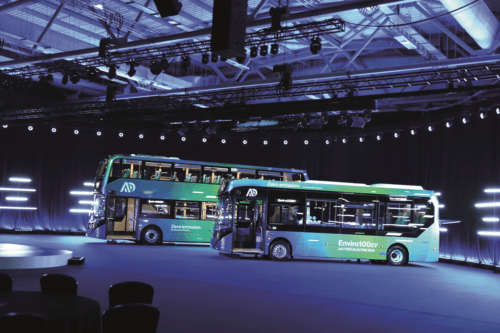
Alexander Dennis has unveiled its next generation of electric buses. Jonathan Welch was at the launch to have a first look
We’ve known It was coming for a while, and on Wednesday 1 November operators were introduced to the latest generation of the Alexander Dennis (ADL) Enviro range. The new Enviro100EV small bus was presented alongside an Enviro400EV double-decker built on the manufacturer’s own electric chassis, as well as an Enviro500EV for KMB in Hong Kong. An Enviro200EV is expected to follow, and for now the new electric buses will sit alongside the BYD chassis offering in the same way that existing buses have been available on Scania chassis as well as Alexander Dennis’ own underpinnings.
Speaking at the launch, ADL Engineering Director Chris Gall said it was a pleasure and an honour to be able to lead the team behind the new buses and to present them to operators and the press. Engineered in house, Alexander Dennis says the new next generation range will offer more choice, more flexibility and more value thanks to industry-leading energy throughput and warranties. “We’ve done everything we can to ensure they meet customer needs using engineering principles,” Chris said, adding that ADL’s customers means operators, passengers and drivers, and praising the work of the design team, behind the new range.
The new Enviro generation also introduces a new design language that ADL says emphasises their zero-emission credentials and allows local authorities and bus operators to make a landmark statement of their investment in a cleaner fleet. Describing the new style at the launch, Chris said that they have been styled to reflect modern building trends, taking cues from modern cityscapes and buildings such as the Shard. The philosophy behind the new look is to show that operators have invested in something new and modern, whilst still retaining a style which is recognisably that of Alexander Dennis, and one which won’t date quickly. Looking at the double-decker, given that both previous generations of Enviro400 still sit well alongside newer models despite being launched in its original incarnation in 2005 (the ‘classic’ version remained in production until 2016, replaced by the ‘MMC’ which was launched in 2014).
[…]By subscribing you will benefit from:
- Operator & Supplier Profiles
- Face-to-Face Interviews
- Lastest News
- Test Drives and Reviews
- Legal Updates
- Route Focus
- Industry Insider Opinions
- Passenger Perspective
- Vehicle Launches
- and much more!


